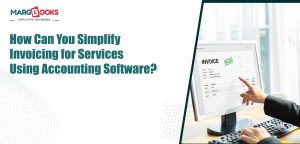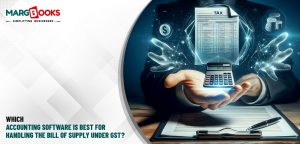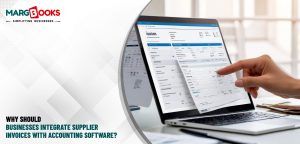Running an e-commerce business comes with its fair share of excitement, and challenges. From handling customer orders to managing returns and marketing, your to-do list never seems to end. Among all these, e-commerce accounting is one task you just can’t afford to get wrong. But the good news? You don’t have to spend hours crunching numbers manually anymore.
With the right online accounting software, you can automate almost every aspect of your accounting workflow. Whether you run a small Shopify store or manage a full-fledged Amazon seller account, automation can simplify your books and give you back your time.
Let’s explore how you can automate e-commerce accounting and which tools can help, including the reliable and India-focused solution, MargBooks.
What is E-Commerce Accounting?
Before we dive into automation, let’s clarify what e-commerce accounting actually means.
In simple terms, e-commerce accounting is the process of recording, managing, and analysing financial transactions related to your online business. This includes:
- Tracking sales and revenue
- Recording expenses (like shipping, packaging, advertising)
- Managing inventory costs
- Filing GST and other taxes
- Generating profit and loss statements
- Reconciling bank statements
Now imagine doing all this manually for thousands of orders—it’s not just tedious, it’s error-prone too. That’s where automation swoops in to save the day.
Why Automate E-Commerce Accounting?
Automation isn’t just a luxury anymore—it’s a necessity for fast-growing e-commerce businesses. Here’s why:
1. Saves Time
Manual bookkeeping takes hours. Automation cuts it down to minutes. You can focus on scaling your business instead of reconciling ledgers.
2. Reduces Human Errors
Let’s face it—we all make mistakes. But accounting errors can cost you heavily in tax penalties or lost revenue. Automated systems ensure accuracy with every entry.
3. Real-Time Financial Insights
With automated accounting software, you get real-time dashboards, helping you make quicker, data-driven decisions.
4. GST Compliance Made Easy
For Indian businesses, filing GST correctly is a big deal. Good accounting software helps you generate GST reports, manage input credit, and file returns seamlessly.
How to Automate Your E-Commerce Accounting?
Here’s a step-by-step guide to help you get started:
1. Choose the Right Online Accounting Software
First things first—select a platform that supports e-commerce integrations and Indian tax laws.
MargBooks is one such cloud-based accounting solution designed especially for Indian businesses. It integrates easily with various e-commerce platforms and provides features like:
- Auto GST calculation
- Inventory management
- Bank reconciliation
- Invoice generation
- Multi-store support
2. Integrate Your E-Commerce Platform
Whether you’re using Amazon, Flipkart, Shopify, WooCommerce, or any other platform, connect it with your accounting software.
This allows automatic syncing of:
- Sales orders
- Customer data
- Refunds and cancellations
- Payment gateway fees
3. Automate Invoice Generation
No more making invoices one by one. Configure your software to auto-generate invoices for every order—GST-ready and fully compliant.
4. Track Inventory in Real-Time
Stock-outs or overstocking can eat into your profits. A good online accounting software like MargBooks offers real-time inventory tracking linked directly with your sales.
5. Automate Bank Reconciliation
Manually matching payments with orders is a headache. Automate this process to match bank transactions with invoices, helping you spot discrepancies instantly.
6. Generate Tax Reports Automatically
Instead of scrambling at month-end or before GST deadlines, let your software compile your tax data throughout the month.
With MargBooks, you can download pre-filled GSTR-1, GSTR-3B and other tax reports in a click.
Features to Look for in an E-Commerce Accounting Software
Here’s what you should check before choosing any platform:
- E-commerce integrations: Amazon, Flipkart, Shopify, etc.
- GST compliance: Auto GST calculation and return filing
- Mobile access: Work from anywhere
- Inventory management: Real-time stock updates
- Data security: End-to-end encryption and backups
- Ease of use: Intuitive interface, even for non-accountants
MargBooks ticks all these boxes and is also built keeping the Indian business ecosystem in mind.
Real-Life Example: How MargBooks Helped an Online Seller
Let’s take the case of Radhika, a Delhi-based entrepreneur who sells home décor products via Amazon and her own Shopify store. Initially, she used Excel sheets and hired a part-time accountant.
But as her business grew, managing orders, returns, and GST became overwhelming.
After switching to MargBooks, she was able to:
- Integrate her Amazon and Shopify sales
- Automatically generate GST invoices
- Get real-time profit reports
- File accurate GST returns without stress
Her workload reduced drastically, and she could finally focus on new product development.
Final Thoughts
In today’s competitive digital landscape, automating your e-commerce accounting isn’t just smart—it’s essential. The right online accounting software does more than just number-crunching; it becomes your financial co-pilot.
Whether you’re just starting or already scaling, tools like MargBooks can streamline your finances, ensure tax compliance, and give you clarity into your business health—all in one place.
So if you’re ready to reduce manual errors, save time, and gain peace of mind, it might be time to ditch the spreadsheets and embrace automation.




